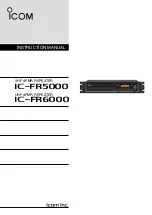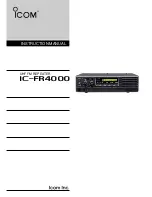
INLET PRESSURE TAP
OUTLET PRESSURE TAP
LOW PRESSURE GAUGE
5
0
10
15
20
25
30
35
GAS CONTROL VALVE
18
WARNING
Fire aand EExplosion H
Hazard
■
Do not disassemble the gas control valve.
■
Do not attempt to replace any components on the gas
control valve.
■
The gas control valve must be placed if any physical
damage occurs to the control valve assembly.
■
Failure to follow this warning will result in fire or
explosions, leading to injury or death to humans and
livestock, and building damage.
TESTING THE MANUAL RESET HIGH LIMIT SWITCH
WARNING
Fire H
Hazard
■
Do not operate the appliance with the high limit switch
bypassed.
■
Operating the heater bypassed high limit switch may
lead to overheating, possibly resulting in a fire, with
subsequent damage to the heater, building damage, or
loss of livestock.
1. Brush off any accumulation of dust that may be found.
2. Check manifold gas pressure with a low pressure gas
gauge:
a. Shut off the gas supply to the heater.
b. Disconnect the heater from its electrical supply.
c. Turn the pressure tap screw at the outlet of the
valve counterclockwise a minimum of one full turn.
d. Connect a low pressure gas gauge to the pressure
tap.
e. Open the fuel supply and reconnect the heater to
electrical supply.
f. Start the heater.
g. When heater lights, the gas gauge will read 25
MBAR for LP vapor or 10 MBAR for natural gas
pressure. This pressure is the flowing gas pressure
necessary for the heater to deliver its maximum
output. If the gauge does not indicate proper
manifold pressure, check the inlet pressure to the
gas control valve. Maximum and minimum
acceptable inlet pressures to the gas control valve
are shown in the heater specifications table and
also on the heater’s dataplate. The inlet pressure
may need adjustment as necessary to achieve
proper outlet pressure. Inlet pressure is checked
in the same manner as outlet pressure.
h. After pressures have been checked, shut off gas
supply and electrical supply to the heater, remove
the gauge, and tighten the pressure tap securely.
Open the gas supply and reconnect the heater to is
electrical supply.
FIG. 14
RESET BUTTON
SENSING
SURFACE
TERMINAL
FLAME
MOUNTING
LEG
The high limit switches should be tested a minimum of once
per year when the heater is given a thorough cleaning.
1. Disconnect the heater from its electrical supply.
2. Remove the high limit switch from the heat chamber.
3. Holding the switch by one of its mounting legs, apply a
small flame only to the sensing portion on the back of
the switch. Be ccareful nnot tto m
melt tthe pplastic hhousing
of tthe sswitch w
when cconducting tthis ttest.
4. Within a minute, you should hear a “pop” coming from
the switch, which indicates the contacts of the switch
have opened.
5. Allow the switch cool down for about a minute before
firmly pressing the reset button on the switch.
6. Check for electrical continuity across the switch
terminals to make sure the contacts have closed.
7. Reinstall the switch back into the heater. Reconnect
the heater to its electrical supply. Start the heater and
check for proper operation.
FIG. 15
















































